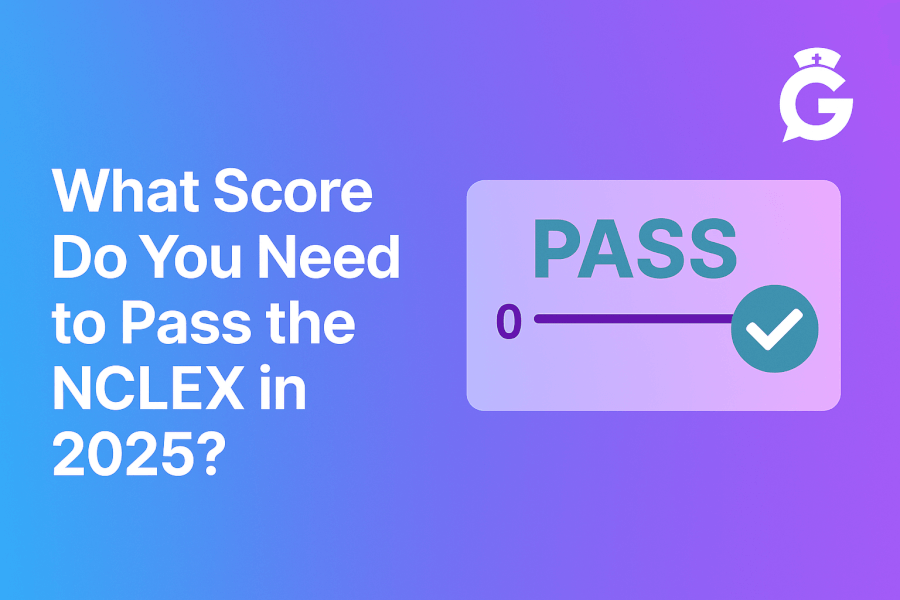Hyponatremia can be sneaky—one minute it’s “a little low,” the next you’re managing headache, confusion, or active seizures. In my years precepting med-surg and neuro floors, I’ve seen students struggle most with what to do first: assess volume status, choose the right fluid, and avoid over-correction. This NGN-ready guide gives you a calm blueprint: concise pathophysiology, prioritized nursing diagnoses with SMART outcomes, and interventions with rationales (seizure precautions, hypertonic saline safety, fluid restriction, and monitoring plans). Use it for simulation, pre-conference, or live bedside care—and document like a pro.
Studying multiple electrolytes? Read our master hub:
The Ultimate Guide to Electrolyte Imbalances - frameworks, tables, and 20+ NGN micro-cases.
🎯 Free NCLEX quiz!
Test your knowledge - new quizzes added weekly!
Pathophysiology of Hyponatremia
Hyponatremia (often Na⁺ < 135 mEq/L; follow your lab range) reflects excess free water relative to sodium. Categorizing by volume status guides treatment:
- Hypovolemic hyponatremia (GI losses, diuretics): total body water ↓, total body Na⁺ ↓↓. Patients look dry; urine sodium varies with cause.
- Euvolemic hyponatremia (SIADH, hypothyroidism, adrenal insufficiency): total body water ↑, Na⁺ normal; exam looks “euvolemic,” urine is inappropriately concentrated.
- Hypervolemic hyponatremia (HF, cirrhosis, nephrotic syndrome): water ↑↑, Na⁺ ↑; edema/ascites common; free-water excess predominates.
Low plasma osmolality shifts water into brain cells → cerebral edema → headache, nausea, gait changes, confusion, seizures, respiratory compromise. Initial priorities are: protect the brain (seizure precautions, hypertonic saline in severe symptomatic cases), control free water (restriction, diuresis, or isotonic fluids per etiology), and treat the cause (med review, endocrine/renal workups).
Fast Assessment & Monitoring Framework (bedside)
- Confirm hypotonic hyponatremia. Review serum osmolality; exclude pseudohyponatremia or hyperglycemia-driven shifts.
- Check volume status. Orthostatics, mucous membranes, edema/ascites, daily weights, I&O trends.
- Urine studies (if available). Urine osmolality and urine Na⁺ help distinguish SIADH vs hypovolemia.
- Neuro watch. Headache, confusion, vomiting, seizures; perform frequent neuro checks.
- Trend sodium (e.g., q4–6h early). Avoid over-correction (commonly ≤ ~8–10 mEq/L in 24 h—follow provider/facility protocol).
Sharpen clinical judgment with NGN resources: Med-Surg Physiological Adaptation Case Studies, electrolyte pattern drills in Electrolytes Cheat Sheet, and mnemonic refreshers in Electrolyte Imbalances Made Easy.
Nursing Care Plans for Hyponatremia
Use these NGN-style diagnoses, outcomes, and interventions with rationales to individualize care for your patient.
Nursing Diagnosis: Risk for Injury (seizures/falls) related to cerebral edema
| Category | Details |
|---|---|
| Related to | Cerebral edema from hypotonic hyponatremia; altered mentation; gait instability |
| As evidenced by | (Risk factors/signs) Headache, confusion, nausea/vomiting, seizures, positive fall risk screen |
| Desired Outcomes | Remains free from injury; no seizures; neuro status improves toward baseline within 24–48 hours as Na⁺ corrects per orders. |
Nursing Interventions and Rationales
| Intervention | Rationale |
|---|---|
| Institute seizure precautions; frequent neuro checks; supervised ambulation; low-stimulus environment. | Reduces injury risk while cerebral edema resolves and therapy begins. |
| Prepare/administer hypertonic saline (e.g., 3%) per protocol for severe symptoms; monitor Na⁺ and osmolality closely. | Careful correction relieves cerebral edema while minimizing osmotic demyelination risk. |
| Ensure bedside availability of airway equipment and rescue meds; escalate for acute neuro change. | Supports rapid stabilization if seizures or airway compromise occur. |
Nursing Diagnosis: Fluid Volume Imbalance (etiology-specific: hypo/euvo/hypervolemic)
| Category | Details |
|---|---|
| Related to | GI/renal sodium losses (hypovolemia), SIADH (euvolemia), or edema states (hypervolemia) |
| As evidenced by | Orthostasis, dry mucosa (hypo); normal exam with low serum osmolality, high urine osmolality/Na⁺ (SIADH); edema/ascites (hyper) |
| Desired Outcomes | Stable vitals and volume status; Na⁺ rises toward target at a safe rate; urine studies trend per etiology. |
Nursing Interventions and Rationales
| Intervention | Rationale |
|---|---|
| Assess volume (vitals, I&O, daily weights, mucosa, edema) and review urine Na⁺/osmolality when available. | Guides therapy choice: isotonic fluids for hypovolemia, fluid restriction for SIADH, diuretics for hypervolemia—per orders. |
| Implement ordered fluid strategy: isotonic saline for hypovolemia; fluid restriction (and solute optimization) for SIADH; loop diuretics ± salt tabs for hypervolemia per provider. | Targets the pathophysiology driving free-water excess while correcting sodium safely. |
| Trend Na⁺ q4–6h initially (facility dependent); avoid rapid correction. | Prevents over-correction and osmotic demyelination; supports timely adjustments. |
🥇Voted #1 Nursing Study Tool.
Personalized AI Tutor + Instant Answers to All Your Questions. 100% Money Back Guarantee!
Nursing Diagnosis: Acute Confusion related to hyponatremic encephalopathy
| Category | Details |
|---|---|
| Related to | Cerebral edema; sedating medications; sleep disruption |
| As evidenced by | Disorientation, slowed responses, poor attention, family report of acute change |
| Desired Outcomes | Oriented ×4, CAM negative, safe environment maintained; cognition improves as Na⁺ corrects. |
Nursing Interventions and Rationales
| Intervention | Rationale |
|---|---|
| Minimize deliriogenic factors (sleep promotion, glasses/hearing aids, day–night cues); reorient frequently. | Supports recovery of cognition while sodium normalizes. |
| Review meds (thiazides, SSRIs/SNRIs, carbamazepine, desmopressin); collaborate on adjustments if implicated. | Addresses common drug-induced or exacerbating causes of hyponatremia. |
Nursing Diagnosis: Deficient Knowledge (hyponatremia safety & prevention)
| Category | Details |
|---|---|
| Related to | Unfamiliarity with fluid strategies, medications (diuretics, SSRIs, carbamazepine), and warning signs |
| As evidenced by | Questions about fluid restriction, salt intake, when to seek care, and lab follow-up |
| Desired Outcomes | Patient/family teach back fluid plan, meds to review, and red-flag symptoms; adheres to follow-up labs as scheduled. |
Nursing Interventions and Rationales
| Intervention | Rationale |
|---|---|
| Teach seizure warning signs (worsening headache, confusion, vomiting) and when to call/return. | Promotes early escalation for neurologic decline. |
| Explain fluid plan (restriction vs rehydration) and medication review (e.g., thiazides, SSRIs, antiepileptics) with the provider. | Addresses common drug-induced or exacerbating causes of hyponatremia. |
| Set expectations for safe correction (often < ~8–10 mEq/L in 24 h, per provider/institutional protocol). | Prevents harm from overly rapid sodium increases. |
NGN Clinical Judgment Pearls (what students miss)
- Type matters: Do not fluid-restrict hypovolemic patients—first fix volume with isotonic saline per order; restriction is for SIADH/euvolemic states.
- Rate matters: Rapid correction risks osmotic demyelination syndrome (ODS); always follow the plan and re-check sodium on schedule.
- Meds matter: Thiazides, SSRIs/SNRIs, carbamazepine, desmopressin are common culprits; bring them up during med reconciliation.
- Neuro checks: Document baseline and changes; small improvements after initial therapy are expected—big swings may signal over-correction.
Frequently Asked Questions (FAQ)
What is the priority nursing intervention for severe hyponatremia with neurologic symptoms?
Protect the brain: initiate seizure precautions, continuous monitoring, and prepare/administer hypertonic saline per protocol—while the team addresses the underlying cause.
How fast can sodium be corrected safely?
Follow provider/facility orders. A common safety target is to limit increases to about 8–10 mEq/L over 24 hours (lower in high-risk patients) to avoid osmotic demyelination.
How do I tell SIADH from hypovolemic hyponatremia?
Assess volume and review urine osmolality and urine Na⁺ when available: SIADH often shows euvolemia with inappropriately concentrated urine and higher urine Na⁺.
Which fluids are used?
Isotonic saline for hypovolemia; hypertonic saline for severe symptoms; fluid restriction for SIADH; and diuretics for hypervolemia—always per provider orders and protocols.
What can families do at home to help prevention?
Follow the prescribed fluid plan, avoid unadvised diuretics and excess free water intake, review new meds with clinicians, and seek care for worsening headache, confusion, vomiting, or seizures.
Further Reading
- Hyperkalemia Nursing Care Plan (First-Hour Priorities)
- Hypokalemia Nursing Care Plan (Safe IV K⁺ & Mg²⁺ Co-Repletion)
- Hypercalcemia Nursing Care Plan
- Hypocalcemia Nursing Care Plan
- Primary Hyperparathyroidism Nursing Care Plan
- Hypercalcemia of Malignancy Nursing Care Plan
- Calcium Kidney Stones (Nephrolithiasis) Nursing Care Plan
- Electrolyte Imbalances Made Easy: Mnemonics
- Electrolytes Cheat Sheet (Na⁺/K⁺/Ca²⁺/Mg²⁺ Patterns)
- ABG Interpretation: 15 Practice Cases
- NGN Med-Surg Case Studies







